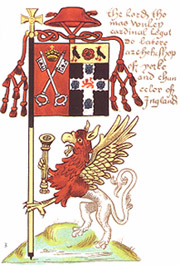
Impalement (heraldry)
Encyclopedia
In heraldry
, impalement is the combination of two coats of arms side-by-side in one shield
or escutcheon to denote union, most often that of a husband and wife, but also for ecclesiastical use. An impaled shield is bisected "in pale", that is by a vertical line.
half (on the right hand of someone standing behind the shield, to the viewer's left), being the place of honour, with the wife's in the sinister
half. For this purpose alone the two halves of the impaled shield are called baron and femme
, from ancient Norman-French usage. Impalement is not used when the wife is an heraldic heiress
, in which case her arms are displayed in an escutcheon of pretence within her husbands' arms, denoting that the husband is a pretender
to the paternal arms of his wife, and that they will descend to the couple's male issue.
 In ecclesiastical heraldry
In ecclesiastical heraldry
, a bishop
's arms are impaled with those of his diocese
or see
, the arms of the see in dexter, and the incumbent's arms in sinister.
Heraldry
Heraldry is the profession, study, or art of creating, granting, and blazoning arms and ruling on questions of rank or protocol, as exercised by an officer of arms. Heraldry comes from Anglo-Norman herald, from the Germanic compound harja-waldaz, "army commander"...
, impalement is the combination of two coats of arms side-by-side in one shield
Shield
A shield is a type of personal armor, meant to intercept attacks, either by stopping projectiles such as arrows or redirecting a hit from a sword, mace or battle axe to the side of the shield-bearer....
or escutcheon to denote union, most often that of a husband and wife, but also for ecclesiastical use. An impaled shield is bisected "in pale", that is by a vertical line.
Marital
The husband's arms are shown in the dexterDexter and sinister
Dexter and sinister are terms used in heraldry to refer to specific locations in an escutcheon bearing a coat of arms and by extension also to a crest. "Dexter" means to the right from the viewpoint of the bearer of the arms, to the left of that of the viewer...
half (on the right hand of someone standing behind the shield, to the viewer's left), being the place of honour, with the wife's in the sinister
Dexter and sinister
Dexter and sinister are terms used in heraldry to refer to specific locations in an escutcheon bearing a coat of arms and by extension also to a crest. "Dexter" means to the right from the viewpoint of the bearer of the arms, to the left of that of the viewer...
half. For this purpose alone the two halves of the impaled shield are called baron and femme
Baron and Feme
In English law, Baron and Feme is a phrase used for husband and wife, in relation to each other, who were accounted as one person by coverture. Hence, by the old law of evidence, the one party was excluded from giving evidence for or against the other in civil questions, and a relic of this is...
, from ancient Norman-French usage. Impalement is not used when the wife is an heraldic heiress
Heraldic heiress
In English heraldry an heraldic heiress is a daughter of deceased man who was entitled to a coat of arms and who carries forward the right to those arms for the benefit of her future male descendants...
, in which case her arms are displayed in an escutcheon of pretence within her husbands' arms, denoting that the husband is a pretender
Pretender
A pretender is one who claims entitlement to an unavailable position of honour or rank. Most often it refers to a former monarch, or descendant thereof, whose throne is occupied or claimed by a rival, or has been abolished....
to the paternal arms of his wife, and that they will descend to the couple's male issue.
Ecclesiastical

Ecclesiastical heraldry
Ecclesiastical heraldry is the tradition of heraldry developed by Christian clergy. Initially used to mark documents, ecclesiastical heraldry evolved as a system for identifying people and dioceses. It is most formalized within the Catholic Church, where most bishops, including the Pope, have a...
, a bishop
Bishop
A bishop is an ordained or consecrated member of the Christian clergy who is generally entrusted with a position of authority and oversight. Within the Catholic Church, Eastern Orthodox, Oriental Orthodox Churches, in the Assyrian Church of the East, in the Independent Catholic Churches, and in the...
's arms are impaled with those of his diocese
Diocese
A diocese is the district or see under the supervision of a bishop. It is divided into parishes.An archdiocese is more significant than a diocese. An archdiocese is presided over by an archbishop whose see may have or had importance due to size or historical significance...
or see
Episcopal See
An episcopal see is, in the original sense, the official seat of a bishop. This seat, which is also referred to as the bishop's cathedra, is placed in the bishop's principal church, which is therefore called the bishop's cathedral...
, the arms of the see in dexter, and the incumbent's arms in sinister.
See also
- DimidiationDimidiationIn heraldry, dimidiation is a method of joining two coats of arms.For a time, dimidiation preceded the method known as impalement. Whereas impalement involves placing the whole of both coats of arms side by side in the same shield, dimidiation involves placing the dexter half of one coat of arms...
(historically earlier method of combining two coats of arms) - Division of the fieldDivision of the fieldIn heraldry, the field of a shield can be divided into more than one area of different tinctures, usually following the lines of one of the ordinaries and carrying its name...

